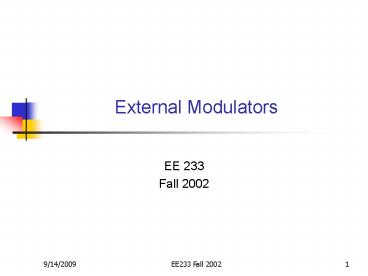External Modulators - PowerPoint PPT Presentation
1 / 25
Title:
External Modulators
Description:
9/6/09. EE233 Fall 2002. 1. External Modulators. EE 233. Fall 2002. 9/6/09. EE233 Fall 2002 ... temperature variation due to carrier modulation ... – PowerPoint PPT presentation
Number of Views:362
Avg rating:3.0/5.0
Title: External Modulators
1
External Modulators
- EE 233
- Fall 2002
2
Outline
- External modulators
- EA modulator
- Electro-optic modulator
- Impact to system builders
- Bit-rate Distance product
- Bit-rate
- WDM Multiplexer/Demultiplexers
- Filter based
- Array waveguide (AWG) router (Si-based)
- Fiber Bragg gratings
- Impact to system builders
- How dense?
3
Optical Modulation
- Direct modulation on semiconductor lasers
- Output frequency shifts with drive signal
- carrier induced (chirp)
- temperature variation due to carrier modulation
- Limited extinction ratio ? because we dont want
to turn off laser at 0-bits - Impact on distancebit-rate product
- External modulation
- Electro-optical modulation
- Electroabsorption (EA) modulation
- Chirp can still exist
- Facilitates integration
- Always incur 6-7 dB insertion loss
4
LiNbO3 crystal properties
- Structure
5
LiNbO3 crystal properties
- Desirable Properties
- High electrooptic coefficients
- High optical transparency near telecom
transmission l - High TC
- Mechanically and chemically stable
- Manufacturing compatibility
6
Modulator Basics
switching curve
modulation response
Insertion loss (dB) 10 log10 (Imax/I0)
Extinction ratio (dB) -10 log10 (Imin/Imax)
7
Typical Electrooptic Modulator
Electrooptic effect
Optical phase shift DF DbO L kODneoL
Local change in index of refraction Dneo
-(n3r/2)Ea
Effective change of index DNeo -(n3r/2)G (V/G)
8
Device design
- Most common electrode configurations (MZI)
9
Fabrication
- Waveguides
- Ti diffusion
- 1000 oC.
- Li out-diffusion must be minimized.
- Annealed proton exchange (APE)
- Acid bath
- 125-250 oC.
10
Fabrication
- Electrodes
- Electroplated.
- Typically Au.
- Deposited directly on LiNbO3 or on optically
transparent buffer layer. - 3-15 mm thick.
11
Fabrication
- Dicing Polishing
- LiNbO3 crystals do not cleave like GaAs or InP
- Diamond saw cutting
- Crystal ends cut at an angle to waveguide to
reduce reflections. - Both ends are polished to an optical finish.
- Must be free from debris and polishing compounds.
12
Fabrication
- Pigtailing Packaging
- subassemblies
- Integrated-optic chip
- The waveguide
- Optical-fiber assemblies
- Input (polarization maintained) and output
(single-mode) fibers - Electrical or RF interconnects and housing
- Package to modulator housing.
13
Modulator Design
- Mach-Zehnder Interferometer
- BW as high as 75 GHz (Noguchi, 1994)
- Use electro-optic effect to vary index
- leverage interference effect
- Directional Coupler
- Use reversed b-coupler
- Requires small waveguide separation for coupling
- Difficult to design for high frequency ? low
speed modulators
14
Device design
- Most popular designs
- Mach-Zehnder Interferometer
- Light is split into two isolated
(non-interacting) waveguides. - Applied electric field from electrode modifies
relative velocities via the electrooptic effect - Hence, a variable interference when light
combined at output.
- Directional Coupler
- Light is split into two or more coupled
(interacting) modes of a waveguide structure. - Applied electric field from electrode modifies
relative velocities and coupling between
waveguide modes. - Hence, a variable interference when light
combined at output.
15
Device design
- Advantages
- Mach-Zehnder Interferometer
- Accommodates large electrode design needed for hi
bandwidth applications. - Higher modulation speed for a given voltage.
- Higher extinction ratio at higher speed.
- Directional Coupler
- Small size and compact
16
Device design
- Enhancing electrooptic efficiency
RF phase-matching buffer/electrode structure
optimized for a modulation frequency
ridge waveguides Increase in Dn and electric field
17
Modulator Design
- Traveling wave electro-optic modulator
- It is necessary to match RF propagation with
optical propagation - Combine with MZI design
- 2-4 cm long and lt6V drive
18
Trade-offs
- Typical dimensions
- Fixed electrode length
- Tradeoffs include bandwidth, Vp, chirp, size and
optical loss - The first three are dominant.
19
System Requirements
- typical NRZ transmitter
20
System Requirements
- DWDM demands various data encoding formats and
modulation techniques
21
Performance
- typical RZ transmitter
22
Reliability
- Quite reliable!
- Failure rate assumptions
- random
- exponentially distributed
- failures in time per 109 device hours (FIT)
23
Reliability
- Bias voltage drift
- not a failure mechanism
24
Reliability
- Phase drift
- bias-free devices
- not a failure mechanism
25
Reliability
- Insertion loss
- minimal losses for 10,000 hours of operation
- good fiber to modulator interface
- robust optical circuit































